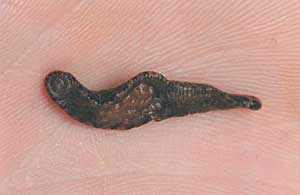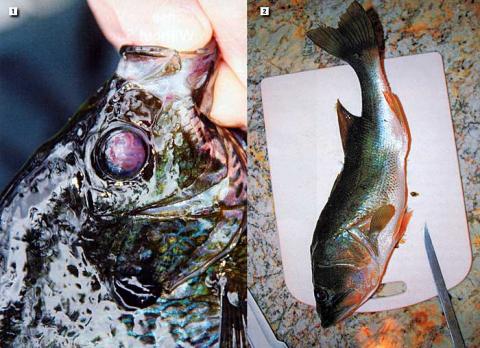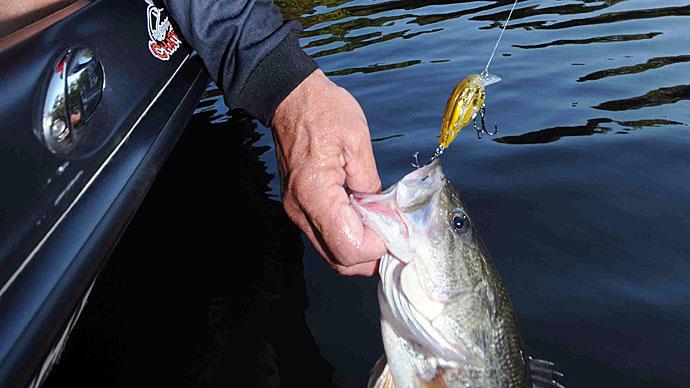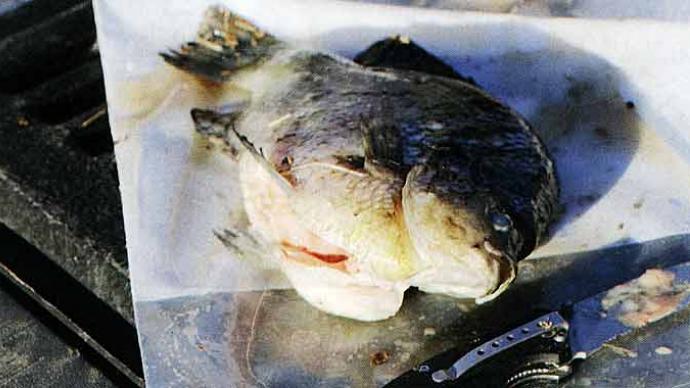
Last fall, I had a spate of phone calls and emails from concerned pondmeisters regarding the health of their fish. While it's common to get an occasional message about fish health issues...maybe three or four a year, it seems nowadays those questions are arising much more often.
How in the world do you decide what to do, when you see what you think is a health issue with your prized fish? It all starts with a proper diagnosis.
Observe your fish's behavior. As you study your pond over the years, you will see patterns of fish behavior. Bass cruise the shallows in cool weather, on the prowl for food, defending their territory or spawning. That's normal behavior. Then, during the extreme months during summer and winter, they move offshore, suspending in deeper water, hovering around structure in mid-depths. Channel catfish can only be seen when you toss a scoop of their favorite feed or when your feeder rhythmically does its magic, pitching those nuggets by the clock. Those catfish are there, conditioned to the time frame of the feeder. Sunfish dart in and out, often easy to see.
Once you understand how your fish are supposed to behave, you should be able to see behavior contrary to what you have learned is natural. At that point, you should be on alert to expect a problem.
Here's what I mean.
If you ever see fish "piping" at the surface, there's a problem. The first thought in your mind is that you have water quality issues and your fish are suffocating.
Maybe so, maybe no.
If there are different sizes of different species of fish, you have water quality issues.
If you see one species of fish behaving un-naturally, you probably have a disease problem.
When you catch a fish with lesions, it might be a problem, it might not.
Here's a primer on beginning the diagnoses of fish problems.
Always pay attention to your water, especially if feeding your fish regularly. As your pond and its inhabitant's age, investigate aeration. Even though a good aeration system seems expensive to you, compare the cost over ten years to what it would cost to replace your fishery one time. Water quality only needs to be "bad" for an hour to cost you your entire pond of fish.
Water quality deteriorates due to an increased load of different nutrients. The biological and chemical processes of breaking down these nutrients are based on temperature and how much oxygen can be mixed into the process. As this organic stuff accumulates, it can become toxic to fish.
The symptoms of bad water quality? Fish rise to the surface and do one of two things. They will either stick their mouths to the surface, gasping for air, or they will congregate and lie lethargically around the edges of your pond. When gasping, the water has been depleted of oxygen. When lethargic, toxins have risen to the surface, causing stressors. Both of these cases most often result in a fish kill. Your best counter measure is to immediately aerate. Back your boat into the water, leave it strapped to the trailer and crank on the outboard motor to move as much water as you can. If you don't have a motor, use a gas-powered or electric water pump to pick up the water and spray across the surface. Get a pond consultant on the phone immediately to properly diagnose the best solution.
When fish are showing signs of diseases, sometimes they will make their way to the surface and stay there, parallel to the surface, backs sticking out of the top of the water. They'll spook and dive when you approach them, but quickly come right back to the top.
These issues are tough to fix, simply because a wholesale treatment isn't practical.
Here's a key point to remember...every health issue with fish is the result of one or more stressors. Every one. It may be due to a rapid rise and fall of water temperature. It may be due to improper handling. It could be due to water quality deteriorating. It might be because of overcrowded conditions. If the stressor is consistent, expect to lose fish.
When my phone rings with fish health issues, there are usually two different circumstances. The most common is when a population of fish is affected.. .those cases where fish are behaving erratically and the pondmeister needs immediate help. The second is where someone caught a fish and sees something wrong with that individual.
At that point, my thinking takes a different direction.
I ask for a digital photo immediately, emailed.
Then, I ask specific questions, based on the inquiry. Most of the time, the fish is seriously underweight and the pondmeister is worried that all his fish are sick. Fish become emaciated for several reasons...sometimes there are a combination of things at work.
Emaciated fish are that way because:
1) That size class of fish or that individual is starving.
a. The pond's natural food chain has been overgrazed by too many predators.
b. The fish is old, dying a natural death.
i. It may appear the fish is declining for other reasons, but if this emaciated fish is not "normal" compared to the other fish of similar size, it could simply be at the end of its lifespan.
c. That fish has a blockage in its digestive system and can't digest its food.
i. When I see this issue, that individual has swallowed several artificial plastic baits and one or more are stuck in its intestines.
ii. There's a hook somewhere along the way, blocking the digestive tract.
2) It is loaded with internal parasites which consume the majority of the fish's food.
a. Usually, the fish deteriorated because it ran out of food and parasites have taken it over.
b. But, if several fish in the population show these symptoms, the parasites might be the issue.
3) It has a disease issue.
4) A combination of one or more of these issues.
Here are some insights into diseases. Fish don't have to be emaciated to have a disease. I have seen perfectly healthy looking fish die quickly from diseases.
For your thought processes, fish diseases can be broken down to two basic types: Bacterial or Viral.
There are a handful of viruses in fish, usually specific to a species of fish. Common viruses are Largemouth Bass Virus Disease and Channel Catfish Virus Disease. There are others. Viral infections show symptoms, but must be diagnosed in a qualified lab. Those symptoms are usually not visible to the eye.
As an aside, viral issues are why governmental agencies have thrown the brakes on fish transport across state lines. Fish producers now must have a disease-free certification in order to transport their fish from state to state. Viruses are becoming more of an issue in today's fisheries management.
Bacterial infections, on the other hand, often show symptomatic signs on a fish. Lesions, boils, rises under the skin, redness anywhere from fins to flesh often signal a bacterial infection.
Parasites can also be an issue. I've seen parasites inside a fish that have completely consumed the ovaries of a female and made them like little yellow rocks. For many, many years, I wouldn't recommend stocking golden shiners in a pond because they carried an inherent parasite that rendered the female sterile after her first spawn. Forage fish that can't spawn are pretty useless to develop a long term forage fish base with that species.
External parasites can also have an effect on young fish. Some of those parasites can be seen with the naked eye, others can't. Fish lice and anchorworms are two of those parasites. Others, such as epistylis, form colonies and can be the cause of irritated skin. That irritation can lead to bacterial infections.
The most common parasites you will see are grubs. These creatures are usually seen as yellow lumps about as big around as a number 2 pencil lead, buried just under the skin, near the fins. Black grubs are often seen in sunfish. They are quite a bit smaller than their yellow cousins.
Fish can even develop tumors. Some can be cancerous, some aren't. I've seen tumors growing on the outside of fish, looking like a grey mass attached onto gills, gill plates or even other parts of the fish. I've seen rock hard, opaque tumors inside a fish that look like small irregular-shaped golf balls.
Here are your take home points.
Diagnose quickly, based on the symptoms. Either you have environmental issues involving your water quality or the food chain of your fishery. If you suspect a disease, put the fish on ice (don't freeze it) or keep it alive. Call your fisheries professional immediately. If you don't have a pro, contact your local veterinarian. Tell your vet you need to ship a sick fish to a fish diagnostic lab for diagnosis. As you await your diagnosis, try to pin down what the issue might be, so you can prepare to deal with it. If your fish have a bacterial infection and are feed- trained, you can mix antibiotics into their feed and start the healing process.
Environmental issues can be corrected by cleansing the water with aeration or adjusting your fish population. A survey by a pond pro can quickly help determine the action plan for these issues.
If your fish have a disease, you need to quickly find out if it affects a few stressed individuals or a larger part of the population.
The bottom line is this...you have worked hard to develop your slice of heaven and what's under water is important to you. Part of that process is to learn about the causes of problems for your fish and what the symptoms are.
Do some homework and you are much less likely to be the one on the other end of the phone when these pond issues rear their ugly heads and my phone rings from an anxious pondmeister.
Reprinted with permission from Pond Boss Magazine




